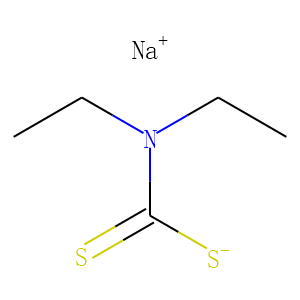| Reference | [1]. Evid Rep Technol Assess (Summ). 1999 Jan;(3):1-5.<br />
Pharmacotherapy for alcohol dependence.<br />
West SL, Garbutt JC, Carey TS, Lux LJ, Jackman AM, Tolleson-Rinehart S, Lohr KN, Crews FT.<br />
PMCID: PMC4781062 PMID: 11487800 [Indexed for MEDLINE]<br />
<br />
[2]. McFarlane, W.D., 1932.<br />
Application of the sodium diethyldithiocarbamate reaction to the micro-colorimetric determination of copper in organic substances.<br />
Biochemical Journal, 26(4), pp.1022-1033.<br />
<br />
[3]. LaCoste, R., Earing, M. and Wiberley, S., 1951.<br />
Colorimetric estimation of various metal derivatives of sodium diethyldithiocarbamate.<br />
Analytical Chemistry, 23(6), pp.871-874.<br />
<br />
[4]. Li, L., Qu, Q., Bai, W., Yang, F., Chen, Y., Zhang, S. and Ding, Z., 2012.<br />
Sodium diethyldithiocarbamate as a corrosion inhibitor of cold rolled steel in 0.5 M hydrochloric acid solution.<br />
Abstract: Sodium diethyldithiocarbamate (DDTC) as a corrosion inhibitor for cold rolled steel (CRS) in 0.5 M HCl solution was investigated by Tafel polarization and electrochemical impedance spectroscopy (EIS). All the data indicate that DDTC can inhibit the corrosion of CRS in HCl solution. Polarization data show that DDTC mainly acts as a good inhibitor though it can accelerate the anodic reaction somewhat. Adsorption of DDTC is found to follow the Langmuir adsorption isotherm. Thermodynamic analysis indicates that both physisorption and chemisorption probably occur in the adsorption process. SEM and FTIR results further validate that DDTC can adsorb on CRS surface.<br />
Corrosion science, 59, pp.249-257.<br />
<br />
[5]. Carlton, W.W., 1966.<br />
Response of mice to the chelating agents sodium diethyldithiocarbamate, α-benzoinoxime, and biscyclohexanone oxaldihydrazone.<br />
Toxicology and applied pharmacology, 8(3), pp.512-521.
|

